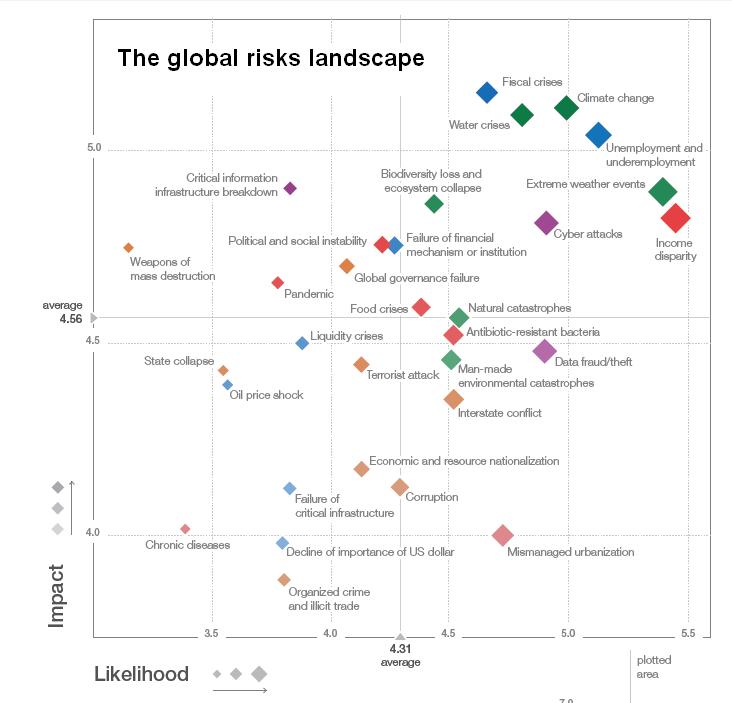Editor’s note: This article is the executive summary from the 57+ page report with a link at the end. The third risk, a water crises, has a solution in the wind industry.
The Global Risks 2014 report highlights how global risks are not only interconnected but also have systemic impacts. To manage global risks effectively and build resilience to their impacts, better efforts are needed to understand, measure and foresee the evolution of interdependencies between risks, supplementing traditional risk-management tools with new concepts designed for uncertain environments. If global risks are not effectively addressed, their social, economic and political fallouts could be far-reaching, as exemplified by the continuing impacts of the financial crisis of 2007-2008.
The systemic nature of our most significant risks calls for procedures and institutions that are globally coordinated yet locally flexible. As international systems of finance, supply chains, health, energy, the Internet and the environment become more complex and interdependent, their level of resilience determines whether they become bulwarks of global stability or amplifiers of cascading shocks.
Strengthening resilience requires overcoming collective action challenges through international cooperation among business, government and civil society
Box 1: Objectives of the Global Risks 2014 Report
The world faces risks that can be addressed only by long-term thinking and collaboration among business, governments and civil society. The Global Risks 2014 report aims to support this process by:– exploring the nature of systemic risks– mapping 31 global risks according to the level of
concern they arouse, their likelihood and potential impact, as well as the strength of the interconnections between them – looking in-depth at the ways in which three onstellations of global risk – centred on youth, cyberspace and geopolitics – could interplay and have systemic impact.
Mapping Global Risks in 2014
Based on a survey of the World Economic Forum’s multistakeholder communities, the report maps 31 global risks according to level of concern, likelihood and impact and interconnections among them. – The risks of highest concern to respondents are fiscal crises in key economies, structurally high unemployment
and underemployment, and water crises (Table 1). – The risks considered high impact and high likelihood are mostly environmental and economic in nature: greater incidence of extreme weather events, failure of climate change mitigation and adaptation, water crises, severe income disparity, structurally high unemployment and underemployment and fiscal crises in key economies. Female respondents perceived almost all global risks as both more likely and more impactful than did males, especially in the environmental category. Younger individuals gave higher scores for the impact of almost all of the risks, particularly environmental risks, such as water crises, greater incidence of natural catastrophes, the loss of biodiversity and greater incidence of extreme weather events.
– The risks perceived to be most interconnected with other risks are macroeconomic – fiscal crises, and structural unemployment and underemployment – with strong links between this macroeconomic risk nexus and social issues, such as rising income inequality and political and social instability. The failure of global governance emerges as a central risk that is connected to many different issues. Mapping perceived interconnections between risks helps to understand the potential transmission channels between them.
– The decline of trust in institutions, lack of leadership, persisting gender inequalities and data mismanagement were among trends to watch, according to survey respondents. Experts added further concerns including various forms of pollution, and accidents or abuse involving new technologies, such as synthetic biology, automated vehicles and 3-D printing.
Ten global risks of highest concern in 2014
1 Fiscal crises in key economies
2 Structurally high unemployment and underemployment
3 Water crises
4 Severe income disparity
5 Failure of climate change mitigation and adaptation
6 Greater incidence of extreme weather events (e.g. floods, storms, fires)
7 Global governance failure
8 Food crises
9 Failure of a major financial mechanism or institution
10 Profound political and social instability
Source: Global Risks Perception Survey 2013 to 2014. Note: From a list of 31 risks, survey respondents were asked to identify the five that concern them most.
For the full report: http://www.oliverwyman.com/content/dam/oliver-wyman/global/en/files/insights/risk-management/2014/Jan/Global_Risks_2014_FINAL.pdf
World Economic Forum
www.oliverwyman.com
Filed Under: News, Policy





